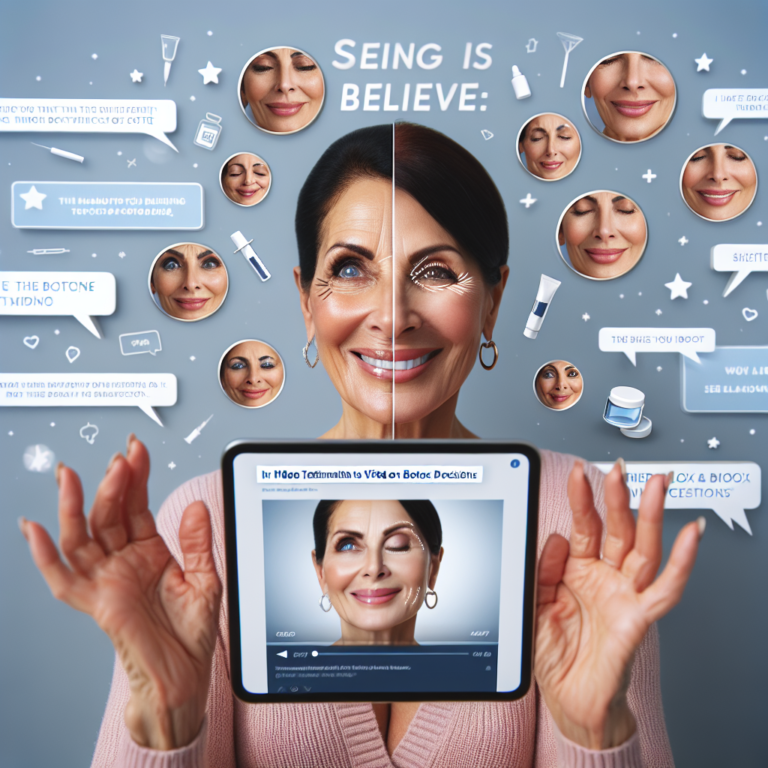Seeing is Believing: The Impact of Video Testimonials on Botox Decisions
In an era dominated by digital communication, visual storytelling has emerged as one of the most persuasive forms of marketing. Among various applications of this trend, video testimonials stand out—especially in the field of cosmetic procedures, such as Botox treatments. As potential patients navigate their choices, the compelling nature of video testimonials can significantly influence their decisions. By providing authentic insights and relatable experiences, these visual narratives have reshaped how individuals perceive and approach Botox treatments.
The Emotional Connection of Video Testimonials
At the heart of any effective testimony is the emotional connection it fosters between the viewer and the subject. Video testimonials capture real people sharing their personal experiences, often infused with genuine emotion—joy, relief, and newfound confidence after receiving Botox. This authenticity resonates with potential clients, making them more likely to trust the experiences shared.
When viewers see faces they can relate to, discussing their insecurities and how Botox helped change their lives, it builds an emotional rapport. In an industry often criticized for unrealistic beauty standards, seeing someone like oneself express satisfaction can be a powerful motivator for action. According to marketing research, consumers are 72% more likely to make a purchase after watching a video testimonial. This statistic highlights the need for cosmetic professionals to leverage video content to reach potential patients effectively.
Addressing Doubts and Fears
For many considering Botox, doubts and fears surrounding the procedure are common. Potential patients often worry about the safety, efficacy, and pain associated with such treatments. Video testimonials provide a platform for individuals to articulate their concerns, share their apprehensions, and subsequently narrate their post-treatment experiences.
When viewers see real people affirming the professionalism of practitioners, highlighting the minimal discomfort experienced during the procedure, and showcasing the natural-looking results, it can significantly alleviate anxiety. Testimonials that include before-and-after footage offer a convincing visual proof of the results, diminishing skepticism and enhancing trust in both the treatment and the provider.
Building Trust and Credibility
Trust is a significant factor when it comes to cosmetic procedures. Video testimonials can effectively build credibility for the practitioner and the treatment itself. By featuring clients who narrate their journey—from consultation to post-treatment satisfaction—clinicians can establish a narrative of care and expertise.
Moreover, the use of video can enhance a brand’s identity, showcasing its commitment to patient satisfaction and transparency. This approach not only personalizes the aesthetic practice but also positions the practitioner as an approachable expert, making potential patients more likely to reach out for consultations.
The Influence of Social Media
Social media platforms have become formidable channels for disseminating video testimonials. Sites like Instagram, Facebook, and TikTok allow practices to reach a broader audience with engaging, bite-sized visual content. As cosmetic procedures become more normalized in society, testimonials shared on these platforms can lead to organic conversations, encouraging potential patients to engage with the content and reconsider their own perceptions of beauty and self-care.
Visual content on social media also capitalizes on the concept of “social proof.” When followers see that their peers are opting for Botox—and sharing positive experiences publicly—it validates the decision to pursue similar treatments. This effect can amplify over time, as sharing and re-sharing testimonials create a ripple effect of influence, potentially leading to a community of informed and confident cosmetic clients.
Conclusion
As cosmetic procedures grow increasingly mainstream, the importance of effective communication strategies cannot be overstated. Video testimonials serve as a dynamic tool within this landscape, allowing potential patients to see firsthand the transformative effects of Botox, confront their fears through shared experiences, and build trust in both the procedure and the provider.
In a world where “seeing is believing,” the weight of video testimonials is undeniable. They not only possess the power to inform and inspire but also to transform perceptions and ultimately influence decisions surrounding Botox treatments. For practitioners looking to enhance their patient outreach and education, investing in authentic video content could be the key to unlocking the potential of new clientele eager to learn more about the possibilities of cosmetic enhancements.


